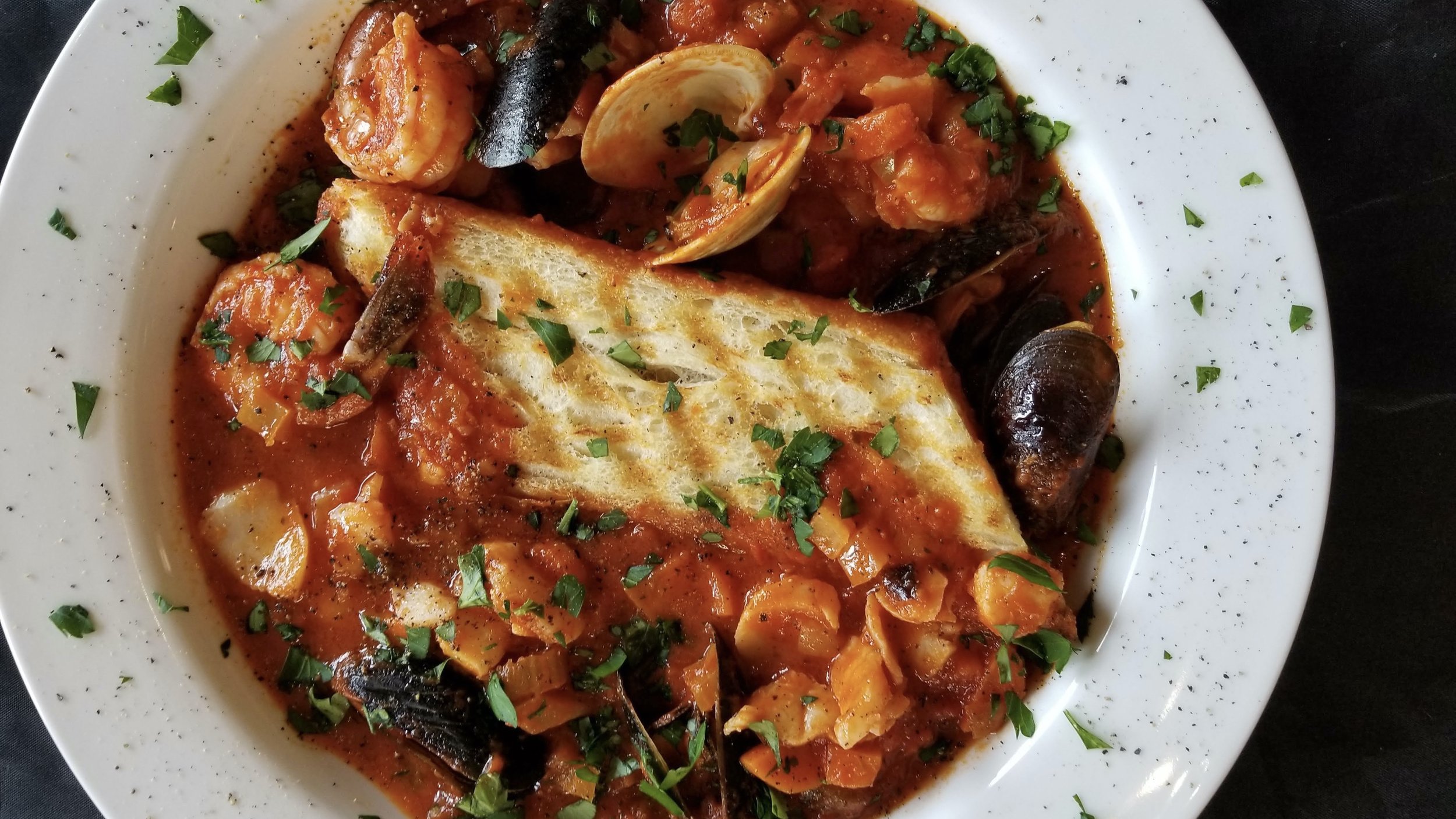CIOPPINO
Read a bit about cioppino—its history, cooking tips, from where comes the name—after the recipe below. Note: “Step 1” freezes admirably, so pack some away for a quick Cioppino when you need it.
A serving of Cioppino for one.
RECIPE: Cioppino
Step 1
Makes 8 cups or slightly more
Ingredients
1/4 cup extra virgin olive oil
2 medium leeks, washed and chopped, white and very light green parts only
1 medium white or yellow onion, peeled and diced small
4 cloves garlic, minced
1 green bell pepper, seeded and chopped small
2 stalks celery, leaves OK, chopped small
1/2 bulb fennel, outer leaves removed and chopped small (no fronds)
1 28-ounce can good-quality San Marzano whole peeled tomatoes and their juice
1 cup white wine (or low-sugar apple juice or ginger ale)
2 cups fish or seafood broth, packaged or homemade
1 teaspoon dried thyme leaves (or 1 tablespoon fresh, no stems)
1/2 teaspoon Mediterranean dried oregano
1/2 teaspoon dried red pepper flakes, lightly crushed with the fingertips
Several grinds of fresh black pepper
Directions
In a large pot over medium heat, warm the olive oil and in it cook the leeks, onion, garlic, bell pepper, celery, and fennel until they are all soft and beginning to break down, anywhere from 15-20 minutes, stirring frequently. Just watch that the heat does not climb excessively and that the garlic does not burn (a lid ajar on the pot may help).
Add the tomatoes and their juice, crushing them with your hands as you put them into the pot, the wine (or wine substitute), the fish or seafood broth, and the herbs and seasonings and bring everything to a simmer. Cook for 10 minutes at a steady simmer, stirring once in a while.
If the liquid is too thick or stew-like, add some water until it reaches the consistency that you like in a soup. Or break up the mixture with a potato masher to your liking (chunky, not so much so; you may even purée it somewhat with an immersion blender).
When cool enough to handle, ladle into containers of whatever measure, in order to store or freeze for the further cioppinos to come.
Step 2
Serves 1
Ingredients
1 and 1/2 cup tomato-based broth from Step 1
1 hefty slice thick-crumbed bread or baguette
1 garlic clove
Extra-virgin olive oil
2 fresh clams
4 fresh mussels
4 chunks firm-fleshed fish (cod, salmon, ocean perch, you decide)
3 large shrimp, peeled and deveined, tails left on
Chopped flat-leaf parsley
Directions
Begin by heating up the cioppino broth in a pot adequate in size to fit it and however many of the remaining ingredients you are preparing. Take the garlic clove and rub it alongside the entire open slice of bread. Brush the slice with olive oil and toast the baguette (in a grill pan, over a fire, or underneath the broiler) until it is nicely browned. Place it, browned side up, in the center of a large, low bowl.
When the broth is slowly boiling, add the clams, stirring in, and cook for 5 minutes, with the pot covered but the lid slightly ajar. Then stir in the mussels, and cook for 5 minutes more; then add the shrimps and firm-fleshed fish and stir again. Simmer gently for another 5 minutes.
To serve, check that the shellfish has opened (discard any that remain unopened) and ladle the broth and fish pieces into the bowl, surrounding the baguette slice. Garnish with the chopped parsley and freshly cracked black pepper.
(Note: This step is very easily multiplied for service for more than one person.)
Cioppino, the fish and seafood stew made famous in San Francisco in the 1800s, is a terrific cool-weather dish. It’s delicious any time of year, of course, but the way it warms all the senses with its vibrant colors, deep flavors, and headily-scented broth is particularly welcoming come the season when the sea is both frigid and fecund.
The way I lay out this cioppino recipe is directed toward solo cooks, but it’s easily adapted for crowds of two or more.
The recipe is in two steps. In the first, you make a soupy broth, in quantity would be my suggestion, portions of which you freeze as the base for future cioppinos. This base freezes admirably.
The second step is merely the ta-da of adding pieces of the piscine to the simmering broth. Note that except, by and large, in the case of mussels, fish and seafood counters readily sell by the piece, another plus for anyone cooking for one.
While cioppino is a coastal dish (its origins go back hundreds of years to the ciuppin of Liguria, Italy), no inland city serviced by airline (that would be Denver, for one example) is more than a few hours away from the same fish or fishing.
The spirit of cioppino is slap-dash; sailors used to construct it while away at sea from whatever their nets might snag on a morning cast. I’ve read descriptions of cioppino in which it is salted with seawater.
To that end, cioppino recipes used to substitute “a bottle of clam juice” (or even a can of—Boomer alert—Clamato juice) to duplicate that maritime air. Nowadays, you will find some superlative seafood broths or stocks (or concentrates of the same) on everyday grocery shelves under the brands Aneto, Bar Harbor, Kitchen Basics, Better Than Bouillon, or More Than Gourmet. Heck, be adventurous (plus, this too is freezer-bound) and make your own.
